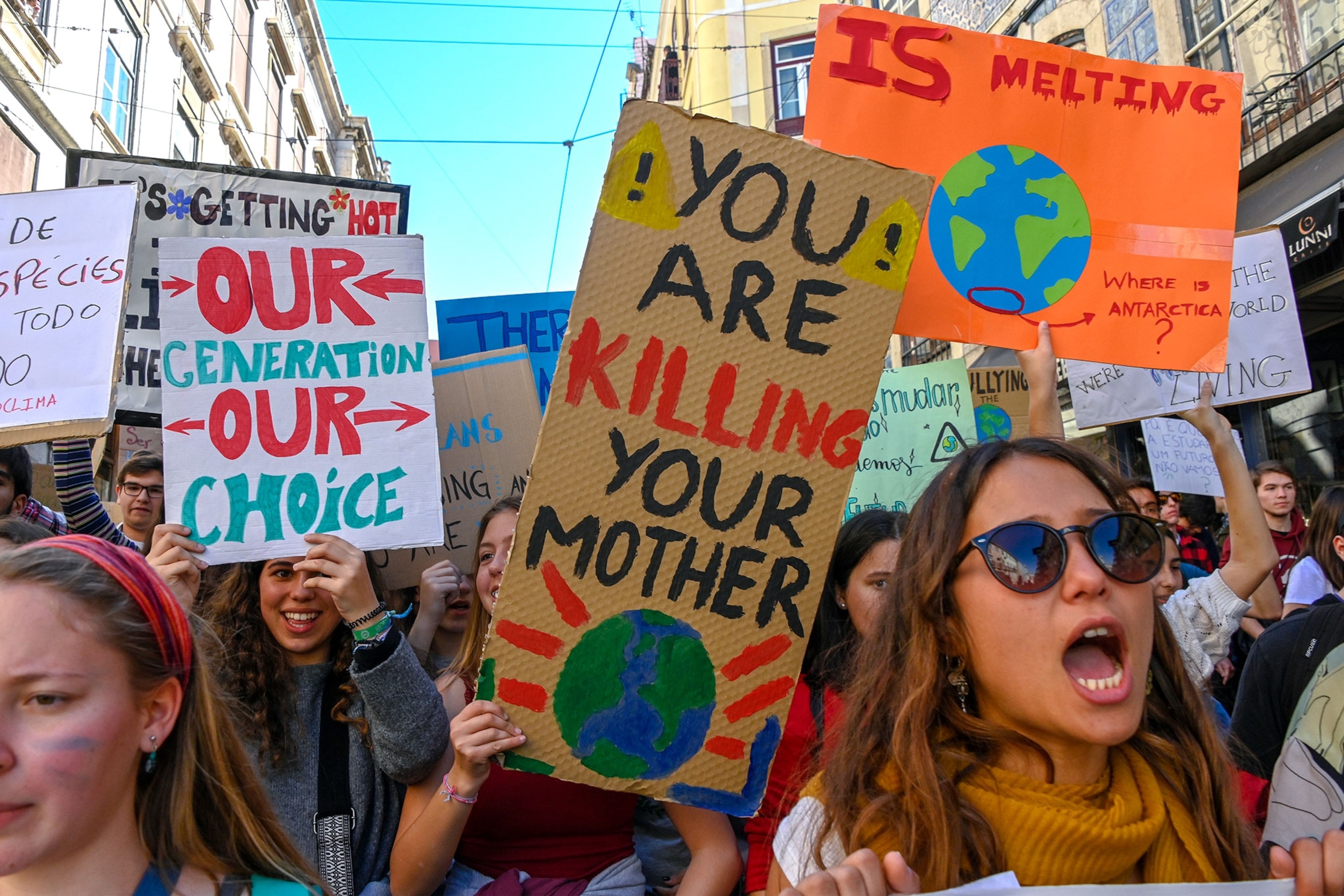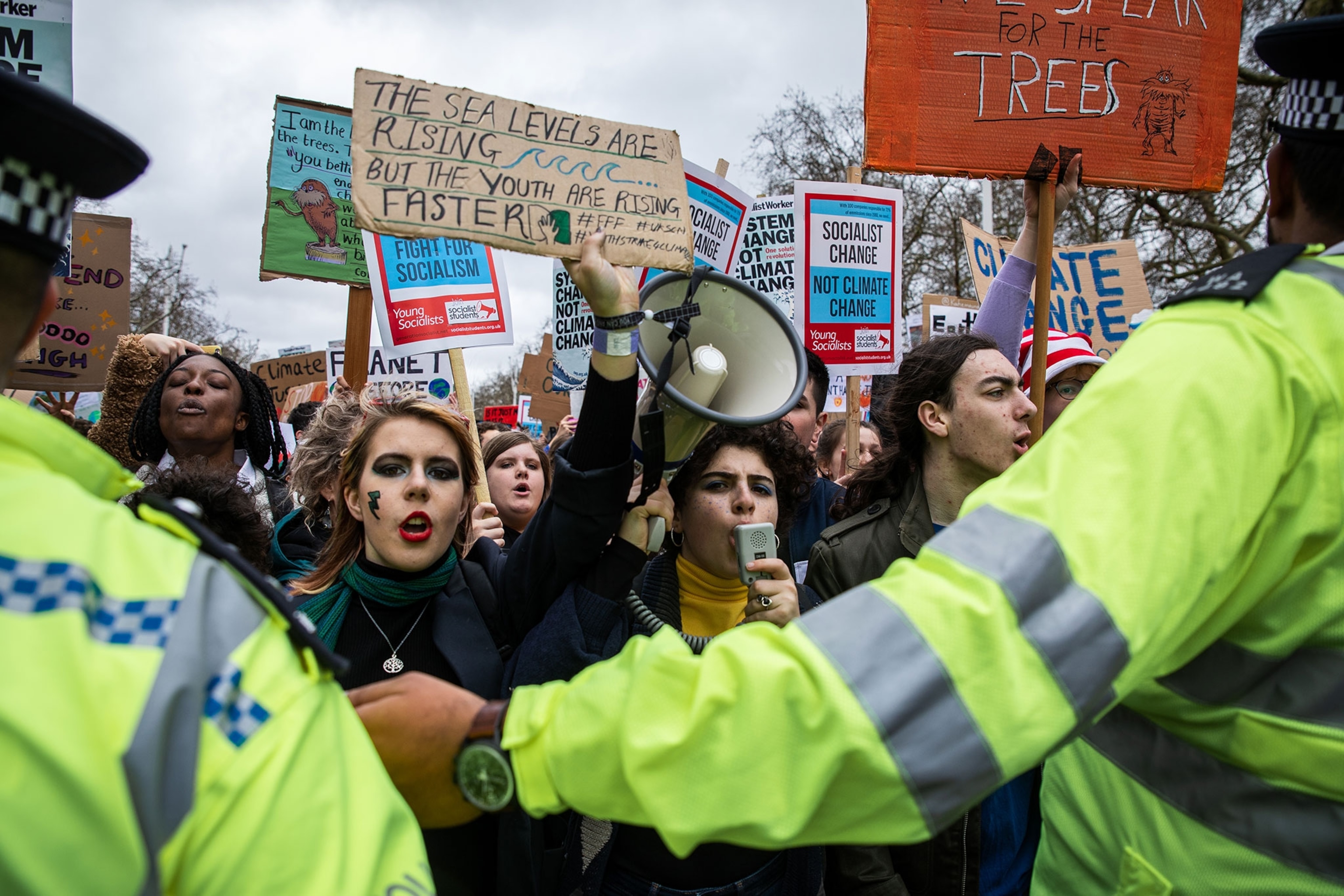













Kids striking against climate change: 'We're fighting for our lives'
From Vanuatu to California, young people went on a "climate strike" to bring attention to the way climate change threatens their futures.
Washington, D.C. — Thousands of young people across the world walked out of school on Friday in massive, internationally coordinated “strikes” to bring attention to what they see as an existential threat: climate change. From Vanuatu to Brussels, throngs of students gathered, waving signs, singing and yelling chants, and clustering together in a coordinated attempt to express their concern to those who have the power to address the issue.
These young people have never experienced a world untouched by climate change—yet they are the ones who will bear the brunt of its impacts, says Nadia Nazar, one of the organizers of the strike in Washington, D.C.
“We’re the first generation that’s being significantly affected by climate change, and the last generation that can do something about it,” she said.
More than 1700 strikes were coordinated so they would run all day, starting with countries to the east like Australia and Vanuatu and sweeping across every continent besides Antarctica. Over 40 thousand students were expected to walk out across Australia, and the streets of major European cities were packed with young people.
A growing movement
The strikes are part of a larger movement that began in the fall of 2018 when Greta Thunberg, a teenager from Sweden, set herself up outside a parliament building in Stockholm with signs and a purpose: Forcing her country’s leaders to acknowledge climate change (and hopefully, do something meaningful about it). She called her actions a “School Strike for Climate.”
Her strikes garnered a little attention, and then more, and then more. Young people around the world started mounting their own, often solitary Friday strikes in their hometowns. In the U.S., 13-year old Alexandria Villasenor bundled up and started striking on a chilly silver bench outside the United Nations Headquarters in New York City; Haven Coleman, 12, posted up outside the Denver State House in Colorado.
But striking each week was a big hurdle for many young people, especially if their schools, friends, or families were unsupportive. As Isra Hirsi, 16, one of the co-leads of the U.S. Youth Climate Strike said on Friday, not everyone can take the time away from school or get themselves to places where they would get attention. But that doesn’t mean they didn’t care about climate change, or want to do something about it.
Hirsi and other young activists wanted to organize a day on which kids across the country could come together in a more cohesive, visible way.
“It’s great if you can go strike every week,” she said, “but it’s also a privilege to be able to do that. And there are so many people who care about this issue who can’t leave school every week or even for this one strike on Friday and we want everyone to have their voice heard.”
“We’re fighting for our lives”
Across the U.S. on Friday, kids gathered at over 100 strikes. Even the night before, the co-leaders’ phones were pinging with requests to add more locations or asking for help figuring out where to go, what to bring, and how to get involved in the grassroots movement.
In Washington, the organizers of the national strike huddled, texted, and planned until late into the evening. They finished a planning session by holding hands and breathing deeply, as Nazar spoke quietly about what they were fighting for.
“We’re fighting for our lives, for people all over the world who are being affected, for ecosystems and environments that have been here for millions and millions of years and are being devastated by our actions over only the past few decades,” she said.
“A crime against our future”
In October of 2018, the IPCC issued a report that warned that without serious, coordinated international action to rein in greenhouse gas emissions, it was nearly certain that the planet would warm by over 1.5 degrees Celsius (2.7 degrees Fahrenheit)—and that the impacts of that warming would potentially be much more disruptive and devastating than previously thought. The timeline? Get emissions in check by 2030.
Many young people around the world heard that number, counted up the years, and realized that they would be in what should be the prime of their lives.
“I have a lot of goals and dreams to achieve by the time I am 25,” says Karla Stephan, a 14-year old organizer of the D.C. strike from Bethesda, Maryland. “But in just 11 years, the damage of climate change cannot be undone. That is simply something I choose not to accept.”
And when they looked around, they saw little or no action being taken to deal with the problem. So, Stephens and many others realized, it was up to them to push the conversation forward.
“Ignorance isn’t bliss,” says Stephan. “It is death. It’s a crime against our future.”
Related Topics
You May Also Like
Go Further
Animals
- This ‘saber-toothed’ salmon wasn’t quite what we thoughtThis ‘saber-toothed’ salmon wasn’t quite what we thought
- Why this rhino-zebra friendship makes perfect senseWhy this rhino-zebra friendship makes perfect sense
- When did bioluminescence evolve? It’s older than we thought.When did bioluminescence evolve? It’s older than we thought.
- Soy, skim … spider. Are any of these technically milk?Soy, skim … spider. Are any of these technically milk?
- This pristine piece of the Amazon shows nature’s resilienceThis pristine piece of the Amazon shows nature’s resilience
Environment
- This pristine piece of the Amazon shows nature’s resilienceThis pristine piece of the Amazon shows nature’s resilience
- Listen to 30 years of climate change transformed into haunting musicListen to 30 years of climate change transformed into haunting music
- This ancient society tried to stop El Niño—with child sacrificeThis ancient society tried to stop El Niño—with child sacrifice
- U.S. plans to clean its drinking water. What does that mean?U.S. plans to clean its drinking water. What does that mean?
History & Culture
- Séances at the White House? Why these first ladies turned to the occultSéances at the White House? Why these first ladies turned to the occult
- Gambling is everywhere now. When is that a problem?Gambling is everywhere now. When is that a problem?
- Beauty is pain—at least it was in 17th-century SpainBeauty is pain—at least it was in 17th-century Spain
- The real spies who inspired ‘The Ministry of Ungentlemanly Warfare’The real spies who inspired ‘The Ministry of Ungentlemanly Warfare’
- Heard of Zoroastrianism? The religion still has fervent followersHeard of Zoroastrianism? The religion still has fervent followers
Science
- Here's how astronomers found one of the rarest phenomenons in spaceHere's how astronomers found one of the rarest phenomenons in space
- Not an extrovert or introvert? There’s a word for that.Not an extrovert or introvert? There’s a word for that.
- NASA has a plan to clean up space junk—but is going green enough?NASA has a plan to clean up space junk—but is going green enough?
- Soy, skim … spider. Are any of these technically milk?Soy, skim … spider. Are any of these technically milk?
- Can aspirin help protect against colorectal cancers?Can aspirin help protect against colorectal cancers?
Travel
- What it's like to hike the Camino del Mayab in MexicoWhat it's like to hike the Camino del Mayab in Mexico
- Is this small English town Yorkshire's culinary capital?Is this small English town Yorkshire's culinary capital?
- This chef is taking Indian cuisine in a bold new directionThis chef is taking Indian cuisine in a bold new direction
- Follow in the footsteps of Robin Hood in Sherwood ForestFollow in the footsteps of Robin Hood in Sherwood Forest




